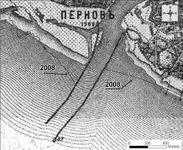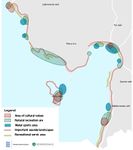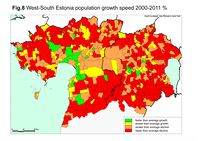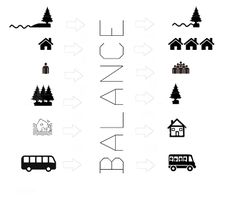COLAND Case Study 2020 - Pärnu - Audru
>>>back to working groups overview
| Area | Pärnu-Audru | |
| Place | Pärnu county | |
| Country | Estonia | |
| Topics | please enter the main coast-related topics here | |
| Author(s) | Marit Mõts, Angela Hõrak, Johanna Kapper, Ragne Nikkel, Nadina Patricija Zaremba | |

| ||
Rationale
Parnu Audru area has both natural areas and a big city on the coastline. The main challenge is to create a balance between valuable natural landscape and human activity. The site is vulnerable to natural forces like sea level rise due to climate change, rain caused flood, waves, wind and erosions.
Location and scope
You can edit this map with the map editor
A Landscape System Analysis
A.1 Landscape layers and their system context
Geomorphology, landscape units and coastal typology
Pärnu-Audru coast line is located in the south – west of Estonia in Pärnu bay and is a part of Pärnu city. Geomorphology of the site was formed by the melting of glacier. Afterwards coastal landscape was influenced by natural forces such as continuing lifting process of Earth’s crust and other. Coastline consists of fine sandy beach and dunes behind it and a protected coastal meadow. Pärnu - one of the biggest Estonian rivers discharges in the sea. The coast line and the sandy beach is changing due to a continuous sedimentation process.
The site is influenced by anthropogenic pressure as well as natural forces. Pärnu city is one of the biggest in Estonia and is a popular tourist attraction, it has a lot of residential, commercial, industrial areas and a port. The pollution created by the city and from river discharge promotes the eutrophication process. The site is vulnerable to sea level rise and affected by winds, waves, ice, and erosions.
Map of Valgerand showing the variations in the position of the coastline from the beginning of the 20th century (denoted by 1900) until 2008 (Estonian Base Map). The striped areas mark erosion (1) and accumulation areas (2). Café Doberan was originally constructed in the 1920s far from the waterline but is located directly at the shoreline today. The sandy section starts from the polder located at the left border of the panel
Land use
Coastline is mostly used for recreational purposes due to scenic white beach behind which there are mostly coniferous and some mixed forests. Bay is used for water sports, fishing and ship traffic. Audru district consists mostly of different arable lands and forests. There is also a built up area and a golf course near the coast. Pärnu is a sparsely built up area. As every city it has residential, recreational and commercial areas, as well as industrial territories and since it is a seaside city and located by the river, it has a busy port. During warm seasons it gets a lot of tourist traffic and the population of Pärnu can even double. Densely built up areas and more natural territories are connected by road and railroad infrastructure. The city has and continuous to develop due to urbanization, growing population and industry as well as natural factors. There are protected nature areas near the site. To the border of Pärnu there is an airport and if it develops the land use is likely to change.
Green/blue infrastructure
GREEN:
- Valgeranna Conservation Area
- Valgeranna Adventure Park
- Valgeranna Golf
- Beach
- Audru polder conservation area
- Reed
- Old Pärnu beach
- Pärnu Beach Park
- Natural grassland
- Natural open area
- Forests
- Fields
- Private gardens
BLUE:
- Pärnu Bay
- River Pärnu
- River Audru
- Pärnu (cargo) port
- Pärnu Pier
- Artificial pond
- Ponds
The availability of green and blue infrastructure is essential for the preservation of natural resources and values such as air quality, water purity and quality, public recreational facilities and climatic conditions. In Pärnu County, in the area between Pärnu and Audru, there are several elements of the green network and green infrastructure, different beaches, parks, people's gardens, rivers, ponds as well as two conservation areas.
Such a network of green and blue infrastructures will improve environmental conditions and thus the quality of life, support the economy and job opportunities, and increase biodiversity.
Green network protects nature from floods, member heat, and also helps to improve air, soil and water quality. Trees and woods in the area help to regulate the distribution of rainwater as they hold large amounts of rainwater. Forests and trees also retain carbon, which in turn improves air quality. Greening also improve people's quality of life, mental health and well-being.
There are also two conservation areas in the area between Pärnu-Audru, which are important sites for biodiversity and also for a better functioning green network. It allows nature to evolve more freely and provides connections between areas to provide the necessary pathways for species.
Different corridors between green and blue areas are useful for crossing different barriers for species. They also connect the green network and the blue network. In the area between Pärnu and Audru, such corridors include the Pärnu River and the Audru River.
The Blue Infrastructure Network includes various wetlands and biotopes that improve water quality and provide habitat for plants, improve soil conditions. Aquatic vegetation purifies water from pollutants and slows down water flow.
Actors and stakeholders
- Who is driving changes in this landscape? Who is affected by those changes?
- Draw a stakeholder and/or power map: Who is affected highly but with low power? Who has high power but is not affected?
Sacred spaces and heritage
As it can be seen in the map most of the cultural monuments in this are are located in Audru. In Audru there is Audru Manor it is typical ensemble of manor buildings. Today 14 buildings are well preserved and undre heritage protection . In Second World War the mansion was destroyed and the office of the state farm was built in ist stead. The stone barn is the oldest building of the manor ensemble with a high saddle roof and walls that are more than a metre thick. There is still a natural stone distillery, maid’s house with a tall chimney, granary and the manager’s house where is now rural municipality’s museum and library. The manor is surrounded by park where flows Audru river with 4 bridges.
Audru Holy Cross Church built in 1680 into the same place where was old wooden church (1636) by Jürgen Grabing from Latvia. The present exterior was designed by major repairs in 1834 and 1872. The stone tower comes from 1715.
Near Valgeranna between pine forest there is old holiday complex. The recreation complex was established for members of the Nomenclature of the ESSR Council of Ministers and for their guests because they needed precious vacation opportunites and representative provisions as for informal meetings of the authorities. The main house included four suites, office rooms and large reception hall with utility rooms. Currently this house is restaurant. The recration complex as a whole is a vivid example of the nomenclature lifestyle, which diversifies th eundrestanding of the possibilities of Soviet construction practice and the bending rules. This Holiday Complex was not subject to standard building norms and guidelines that time.
The Old-Pärnu Cemetery dates back to the 15th century and is still in use today, with repeated rulings.
There is also a lot of heritage areas that has been destroyed and there is no visible signe about them but the maps provide information about their former existence. For example Audru fishflour factory, Audru battlefield, Audru parish school, Audru landlords' cemetery.
Visual appearance and landscape narrative
This case study area is located on the coast of Pärnu Bay. Essential landscape characters of this area are sandy beaches, pine woods, old houses/apartments and beautiful views along the coast. Those views are quite magical and have also been painted by many hobby artists. One painting called Valgeranna is painted in 1962 by an Estonian artist called Enno Lehis. The painter used watercolors to show the atmosphere of this white sandy beach with beautiful pine forest. In addition to beautiful views, there are lots of other paintings about this study area. Maybe the most famous one of them all is called Pärnu jõgi painted in 1957 by Elmar Kits. It shows the view from the Vana Pärnu town to the Pärnu river. Furthermore, this case study and its surroundings have represented the filming location for a number of movies and documentaries. One of them, Yachts at Sea (in Estonia called: jahid merel), was directed by Mihhail Jegorov in 1955 and this movie tells the story of young yachtsmen from the coastal town who deals with daily work, training and competitions without knowing about the downside. Another movie that captures the coastal landscape of Valgeranna and its surroundings is movie called Behind the Door (in Estonia called: Ukse taga), made in 2004.
A.2 Summary of your landscape system analysis and your development targets
- You can summarize your findings with an DPSI(R) Model or a Spider Diagram
- Link back to the Sustainable Development Goals: Which goals are at risk?
- What is your hypothesis for this landscape?
- Visualise your hypothesis with one graphic/pict
- Are there any existing initiatives taking action in this landscape? Do you have a critical perspective on that?
- Add text and visuals
A.3 Theory reflection
International policy: Guiding Principles for City Climate Action Planning
Cities are beginning to realize the benefits of climate change. Facilitating climate change and the various mitigation measures that result from it will help cities meet their own development trends and priorities, address social challenges and environmental problems affecting cities. At the same time, cities are responding to other international action plans, such as the goals set out in the Sustainable Development Goals.
European policy: Maritime spatial planning
For renewable energy equipment, aquaculture and other uses – it has highlighted the need to manage our waters more coherently. Maritime spatial planning works across borders and sectors to ensure human activities at sea take place in an efficient, safe and sustainable way. That is why the European Parliament and the Council have adopted legislation to create a common framework for maritime spatial planning in Europe.
European policy: Communication on Green Infrastructure
Based on Communication on Green Infrastructure is it a strategically planned network of natural and semi-natural areas with other environmental features designed and managed to deliver ecosystem services such as water purification, air quality, space for recreation and climate mitigation and adaptation. The European Commission has developed a Green Infrastructure Strategy, the purpose of the document is that the protection, restoration, creation and enhancement of green infrastructure become an integral part of spatial planning. In our case, Pärnu–Audru area includes urban and rural sites, to improve citizens' life quality and health, implementation of this method, by maintaining forests and Pärnu bay area, is essential
National policy: National Spatial Plan Estonia 2030
The main development objectives are balanced and sustainable settlements, convenient mobile facilities, make the energy infrastructure more available and to improve green infrastructure connections as well as preserve existing landscape values. When it comes to marine areas, sustainable and efficient utilization of them is important for international competitiveness. Planning and balance are key for the preservation of waterbodies and nature and providing possibilities for recreation, tourism, commercial activities and national defence.
A.4 References
- give a full list of the references you have used for this section
Phase B: Landscape Evaluation and Assessment
B.1 Assessment Strategy
- Based on the hypothesis derived from your previous landscape systems analysis you are now asked to define the goals for assessing the landscape. Your assessment is the basis for evaluating the landscape status.
- Which elements and phenomena need to be mapped, why and how?
- This a text contribution, max 250 words
B.2 Mapping
- As defined by your assessment strategy you conduct the mapping and present your findings here
- As a minimum, at least three different themes need to be mapped, you may choose more if needed
- Your case your assessment mapping themel.jpg
briefly explain the findings of your mapping
- Your case your assessment mapping theme2.jpg
briefly explain the findings of your mapping
- Your case your assessment mapping theme3.jpg
briefly explain the findings of your mapping
B.3 Problem definition and priority setting
- Give a summary of the major findings of your mapping process, what are the problems/potentials identified?
- Draw a problems/potentials map
- Set priorities for the most relevant issues
- Your case problems potentials map.jpg
add caption here
B.4 Theory reflection
- Please reflect the assessment and evaluation methods used based on at least three readings
- Did you encounter limitations'
- 200 words test contribution
B.5 References
- give a full list of the references you have used for this section
Phase C – Strategy and Master Plan
C.1 Goal Setting
- Define strategic planning objectives based on the evaluation findings
- Link back to your original targets from section one and the Development Goals
- 150 words text contribution
C.2 Spatial Strategy and Transect
- translate your strategic goals into a vision
- develop a spatial translation of your vision
- exemplify your vision in the form of a transect with concrete interventions
- add map(s) and visualizations
- Your case spatial translaton vision.jpg
add caption here
- Your case transect.jpg
add caption here
- Your case transect detail1.jpg
add caption here
- Your case transect detail2.jpg
add caption here
C.3 From Theory of Change to Implementation
- For implementing your vision: Which partnerships are needed? Which governance model is required?
- Who needs to act and how? Draw and explain a change/process model/timeline
- Which resources are needed? On which assets can you build?
- add 150 words text and visuals
- Your case spatial your governance model.jpg
add caption here
- Your case spatial your process model.jpg
add caption here
C.4 References
- give a full list of the references you have used for this section
D. Process Reflection
- Reflect in your intercultural and interdisciplinary team on the outcomes of your study
- Which limitations were you facing?
- What have you learnt from each other?
- What would you do differently next time?
- You can also use diagrams/visuals
- 250 words text


















